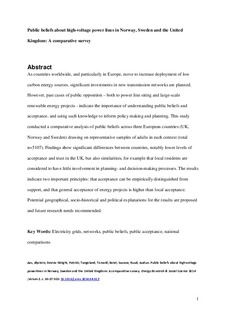| dc.contributor.author | Aas, Øystein | |
| dc.contributor.author | Devine-Wright, Patrick | |
| dc.contributor.author | Tangeland, Torvald | |
| dc.contributor.author | Batel, Susana | |
| dc.contributor.author | Ruud, Audun | |
| dc.date.accessioned | 2017-11-20T09:28:38Z | |
| dc.date.available | 2017-11-20T09:28:38Z | |
| dc.date.created | 2014-06-11T09:58:48Z | |
| dc.date.issued | 2014 | |
| dc.identifier.citation | Energy Research & Social Science. 2014, 2 30-37. | nb_NO |
| dc.identifier.issn | 2214-6296 | |
| dc.identifier.uri | http://hdl.handle.net/11250/2467088 | |
| dc.description.abstract | As countries worldwide, and particularly in Europe, move to increase deployment of low carbon energy sources, significant investments in new transmission networks are planned. However, past cases of public opposition – both to power line siting and large-scale renewable energy projects – indicate the importance of understanding public beliefs and acceptance, and using such knowledge to inform policy making and planning. This study conducted a comparative analysis of public beliefs across three European countries (UK, Norway and Sweden) drawing on representative samples of adults in each context (total n = 5107). Findings show significant differences between countries, notably lower levels of acceptance and trust in the UK, but also similarities, for example that local residents are considered to have little involvement in planning- and decision-making processes. The results indicate two important principles: that acceptance can be empirically distinguished from support, and that general acceptance of energy projects is higher than local acceptance. Potential geographical, socio-historical and political explanations for the results are proposed and future research needs recommended. © 2014 Elsevier Ltd. All rights reserved. Electricity grids Networks Public beliefs Public acceptance National comparisons | nb_NO |
| dc.language.iso | eng | nb_NO |
| dc.rights | Attribution-NonCommercial-NoDerivatives 4.0 Internasjonal | * |
| dc.rights.uri | http://creativecommons.org/licenses/by-nc-nd/4.0/deed.no | * |
| dc.title | Public beliefs about high-voltage powerlines in Norway, Sweden and the United Kingdom: A comparative survey | nb_NO |
| dc.type | Journal article | nb_NO |
| dc.type | Peer reviewed | nb_NO |
| dc.description.version | acceptedVersion | nb_NO |
| dc.subject.nsi | VDP::Samfunnsgeografi: 290 | nb_NO |
| dc.subject.nsi | VDP::Human geography: 290 | nb_NO |
| dc.source.pagenumber | 30-37 | nb_NO |
| dc.source.volume | 2 | nb_NO |
| dc.source.journal | Energy Research & Social Science | nb_NO |
| dc.identifier.doi | 10.1016/j.erss.2014.04.012 | |
| dc.identifier.cristin | 1137414 | |
| dc.relation.project | Norges forskningsråd: 207774 | nb_NO |
| dc.relation.project | Andre: Statnett SF | nb_NO |
| cristin.unitcode | 7511,5,0,0 | |
| cristin.unitname | Lillehammer | |
| cristin.ispublished | true | |
| cristin.fulltext | postprint | |
| cristin.qualitycode | 1 | |

